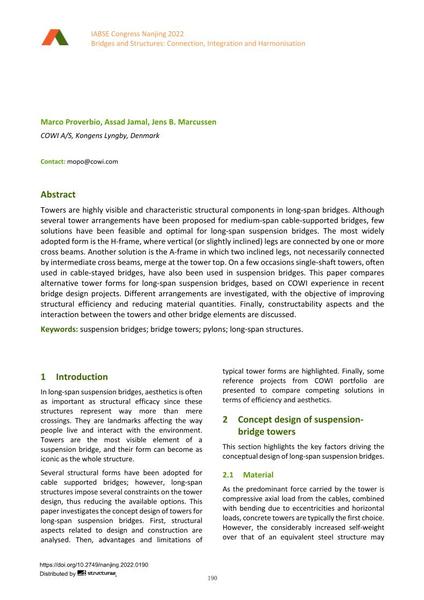Conceptual Design of Long-Span Suspension Bridges: Tower Structural Forms

|
|
|||||||||||
Détails bibliographiques
| Auteur(s): |
Marco Proverbio
(COWI A/S, Kongens Lyngby, Denmark)
Assad Jamal (COWI A/S, Kongens Lyngby, Denmark) Jens B. Marcussen (COWI A/S, Kongens Lyngby, Denmark) |
||||
|---|---|---|---|---|---|
| Médium: | papier de conférence | ||||
| Langue(s): | anglais | ||||
| Conférence: | IABSE Congress: Bridges and Structures: Connection, Integration and Harmonisation, Nanjing, People's Republic of China, 21-23 September 2022 | ||||
| Publié dans: | IABSE Congress Nanjing 2022 | ||||
|
|||||
| Page(s): | 190-198 | ||||
| Nombre total de pages (du PDF): | 9 | ||||
| DOI: | 10.2749/nanjing.2022.0190 | ||||
| Abstrait: |
Towers are highly visible and characteristic structural components in long-span bridges. Although several tower arrangements have been proposed for medium-span cable-supported bridges, few solutions have been feasible and optimal for long-span suspension bridges. The most widely adopted form is the H-frame, where vertical (or slightly inclined) legs are connected by one or more cross beams. Another solution is the A-frame in which two inclined legs, not necessarily connected by intermediate cross beams, merge at the tower top. On a few occasions single-shaft towers, often used in cable-stayed bridges, have also been used in suspension bridges. This paper compares alternative tower forms for long-span suspension bridges, based on COWI experience in recent bridge design projects. Different arrangements are investigated, with the objective of improving structural efficiency and reducing material quantities. Finally, constructability aspects and the interaction between the towers and other bridge elements are discussed. |
||||
| Mots-clé: |
pylônes
|
||||
| Copyright: | © 2022 International Association for Bridge and Structural Engineering (IABSE) | ||||
| License: | Cette oeuvre ne peut être utilisée sans la permission de l'auteur ou détenteur des droits. |
||||

